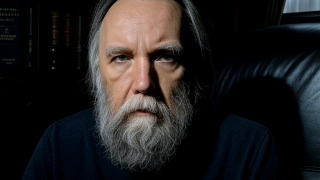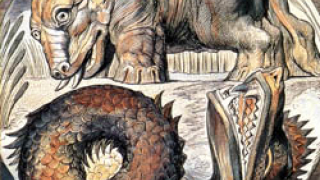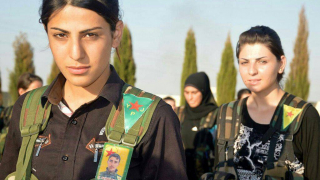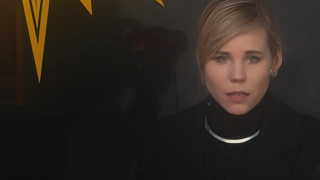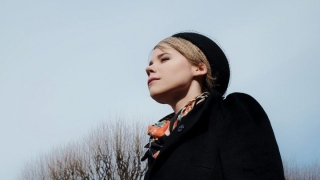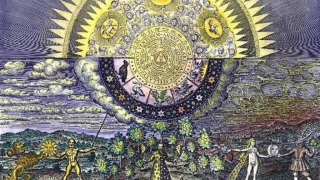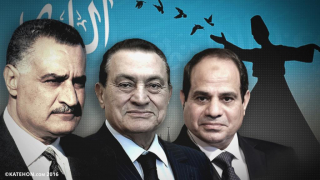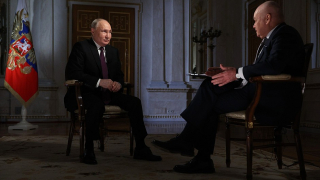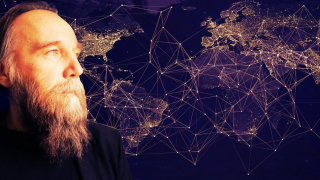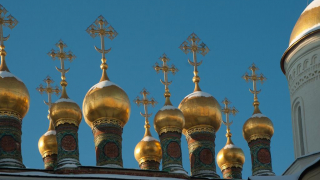The rehabilitation of the sacred
The series of programs by M. L. Khazin and K. A. Gevorgyan (“Economics in Russian” and “The CUP meeting on January 11, 2024”) was devoted to an important and interesting, but still little addressed aspect outside of Eurasian, traditionalist or theological discourses: the aspect of the sacred. Let us reflect on this theme from a Eurasian perspective.
Why is it that some teachings manage to reach the heart immediately and settle there willingly and for a long time, while others have to be indoctrinated long and aggressively, with no guarantee that they will be forgotten as soon as the source of propaganda is turned off? Gramsci's cultural hegemony is an extremely powerful tool for promoting ideology to the masses, but it is “philosophizing with a hammer” when ideologues are literally driven into the public consciousness like nails. As we know, a colt armed with a good word works wonders. So perhaps, in addition to “philosophizing with a hammer,” there is “philosophizing with a good word”?
Philosophizing with a good word is there because it cannot not be there. The good word is the Good News, which is an indisputable truth about which we do not have the slightest doubt because we discover it with our hearts. This truth is indisputable because it is holy, because it has a sacred meaning.
What then is the sacred?
The metaphysics of the sacred
According to the traditionalist view, the sacred is a noomenon found in the metaphysical realm, which can be contemplated directly only by people who have this gift (prophets and poets), while we mortals can perceive it only in rare moments of inspiration (descending grace) or reconstruct it from the phenomenal world through special procedures (through prayer, contemplation or intellectual insight). It is important to realize that the noumenon is not an eccentric fiction of an NLP coach, but is a real object-even if the word “object” is not quite appropriate (in metaphysics there is no Cartesian division between object and subject; in metaphysics, to understand the noumenon, one must become it, not depart from it) and this reality is of a special kind, it is a meta-reality.
A certain analogy may be mathematics, which the Pythagoreans and Platonists sacralized without a shadow of hesitation, placing it in the realm of eidos and logos - that is, in metaphysics. Mathematical laws and structures are not arbitrary (only the choice of axioms is relatively arbitrary); we do not invent mathematics, we discover its laws.
The same goes for the sacred and metaphysical side of phenomena: it is not necessary to invent it, it is necessary to discover it. And the more fully we discover it, the more alive and holy becomes the object of our study with the “vision of the heart.” We begin to recognize God's design for the phenomenon, to discover its true meaning.
We can say that the sacred is what connects physics and metaphysics, the lower world and the higher world. The sacred is the lumen by which the upper world shines into the lower world, in the light of the sacred we unmask the false and the obscure and recognize the true and the light. The wider the lumen, the brighter the light of the mountain, the greater the spaces illuminated and sanctified by it.
For a long time, we have been immersed in the world of secular ideologies, which have turned their backs on the mountain and have been concerned only with worldly arrangements. “But is that such a bad thing? - the reader raised in the secular world will ask us. - What is bad about humanistic projects steeped in concern for man and his daily bread?” Alas, it is incredibly bad, it is simply an indescribable horror, it is disgusting. Because our plans and projects, constructed without regard to God's Providence, sooner or later come into disagreement with Him, or even into direct contradiction. And as a result, sooner or later they collapse like a house of cards or the Tower of Babel, covering the unfortunate planners with rubble. Woe to the builders who do not know the laws of copromatism and universal gravitation, but woe also to the shepherds who lead their flocks without a spiritual compass.
Modernity has come under the banner of arrogant faith in human reason. Postmodernity has confirmed the precariousness of human truths and ridiculed them. Man no longer has anything to rely on, no one to count on. Money, power, society: everything is discredited and meaningless to such an extent that it seems that nothing can save the world.
If, however, the world is not completely lost, if there is at least a chance to save it, then perhaps we should try. And to do that, we need to take the world back a little, to the point where everything went wrong. If the “going wrong” began with the beginning of the Modern, then the point of restoring the original state of the world should be sought in the Premodern. If traveling along the tracks of the Modern has led us to a dead end, then we must return to the point of entry and choose another path, one that does not cause us to lose our living connection with the Real. We experience the encounter with the Real as sacred and recognize the sacred through religion.
What is the fundamental difference between the premodern and the modern? Only one thing: the presumption of the Sacred. The sacred, the sacred must no longer remain in the backyards of a society secularized to the core - it must fully enter our world, infuse it with life and spirit, fill it with the truth of God. Everything must be from God, overshadowed by the grace of the Holy Spirit: history, the future, power, daily life. We repeat so often that “all authority comes from God” that we have completely lost the meaning of this maxim. When power is delegated through the ballot box, we can ask whether it comes from God. Has He not found a nobler object than a basket for His mission? Only that power that comes from God, in which the sacred is present, whose mandate is received from heaven and not randomly drawn from the urn like a lottery ticket.
The sacred dwells beyond the horizon of human life; it is more precious than human life. It must dwell in Eternity to carry eternal values. Turning to the sacred is an extremely radical step, the radicalness and totality of which we have not yet realized. We must decisively break with the attitudes of modernity, with its maniacal desire to rationalize, catalog and put everything in its place. To become Paul, one must stop being Saul.
Levels of the sacred
When we speak of the sacred, it is to metaphysics that we appeal. The metaphysical prototype and the physical image relate as punch and matrix. The punch is the ideal original, existing in Eternity, while the matrix is a snapshot, a temporary snapshot. At the same time, the snapshot can be a very distorted copy, or even a simulacrum, a copy without the original (when we invent sacredness, we sacralize purely phenomenal or infernal layers).
If the layer of the sacred is not the only one, then we must examine it carefully so as not to fall into spiritual illusion and worship inferior deities (or even demons).
In her talk, Karine Gevorgyan shares an important sociological observation to explain the phenomenon of the sacred. The anthropologist and linguist Georges Dumézil, who made the Ossetian epic famous, found that Indo-European society is always organized on a tri-functional basis, consisting of three layers, the varnas, priests (Brahmins), warriors or nomads (kshatriyas), and merchants or peasants (vaishyas). The Russian world is part of the Indo-European space, and trifunctionality is an integral part of our identity. We can be priests (bearers of the ideal type), warriors (ideal type), merchants (sensual type). Once this division was rigid, class-based; now it is present implicitly, as a mode of consciousness (which does not diminish the role of this division). People look at the world from one of three positions: “priest,” “warrior,” or “merchant.” The “merchant” looks at the world in terms of money, the “warrior” looks at the world in terms of war, life and death, while the priest seeks God and God's Providence in everything.
In the absence of priests and their sacredness, representatives of the lower “varnas” (to avoid misunderstanding, we take this term in quotes, meaning by it the type of consciousness, not class affiliation) begin to find sacral bases for themselves. The sacralization of certain aspects of social existence (or even things) also occurs when a certain “varna” attains power. This is how different levels of the sacred are produced.
When the sacred begins to be formulated by the merchant class, the bourgeoisie, pagan worship of Mammon, the golden calf, black magic. The new pagans build their pagan temples, the banks, where specific priests, the bankers, reign. One only has to look at Herman Gref to realize that he is not just a “white collar” person: he is a devoted servant of the cult with a very specific religious vision. This sacredness is a simulacrum that has no prototype in the metaphysical world (except that in Infernum there is Tolkien's magical “ring of omnipotence” that spawns legions of Gorlum worshipers on earth).
The warrior class articulates and shapes heroic sacredness. This is already a real, if inferior, sacredness. It grasps only certain aspects of Authenticity and begins to worship them, ignoring the subtler and higher metaphysical levels. Heroic sacredness absolutizes war and victory, not caring too much about the image of the world. The metaphysics of the Red Project, presented in the USSR after the end of the civil war and Lenin's death, became a model of heroic (even titanic, God-fighting) sacredness by building a grandiose necropolis, a pantheon of fallen heroes in Red Square, the symbolic center of Russia. In the USSR, the heroic sacredness of wartime communism worked perfectly when it was necessary to fight, mobilize, rebuild the destroyed country, participate in nuclear and space races. But it ran hopelessly aground, unable to present a truly sacred peaceful social ideal to society. “But their misfortune was victory -- behind it a vacuum opened”: these lines by Naum Korzhavin accurately convey the crisis of sacredness of the victors' generation. Peace communism (of the Khrushchev variety) presented an extremely miserable, consumerist, vulgar and bourgeois image of the future, which naturally gave rise to bourgeois “sacredness” and led to the victory of those to whom this image was close - the bourgeoisie.
Military sacredness is exploited with no less success by your enemy in Ukraine, which practices the Nazi cult of Bandera and Shukhevich and glorifies its heroes. Therefore, to win the war with them (and with the West as a whole), you must present a higher level of sacredness.
True sacredness can only be recognized by the priestly heritage, which is almost completely absent in our country. It is absent as an institution of spiritual pastoralism, which exists in Iran, which we had in the Orthodox Church (in pre-Roman times), but which now manifests itself only sporadically in elders, poets, individual philosophers, gracious batiushkas and ascetics. Our metaphysical, metapolitical and metahistorical ideal is deeply hidden behind the mythologems “Grad Kitezh,” “Belovodie,” “Holy Russia,” “Third Rome.” Holy Russia represents not only the territory and the people, but also a deeply original idea of an eternal spiritual realm, the life of the future age. Holy Russia harmoniously combines Orthodoxy with folk customs and traditions, humanism and justice with God's Providence. It is an embodiment of the Eurasian idea-kingdom, which is the highest instance of the ideocratic hierarchy. Russia then and only then approaches the ideal of holy Russia when it follows the wise precept of the ruler Ivan the Terrible: “The Russian land is held up by the mercy of God, by the grace of the pure Mother of God, by the prayers of all the saints, by the blessing of our parents, and finally by us, our rulers, and not by judges and voivodes.
The people as sacredness
Mikhail Khazin in the program “Meeting of the CUP on January 11, 2024” formulates a remarkable thesis: “The Russian people are bearers of sacredness.” This important and profoundly Eurasian formula must be understood well so as not to fall into the temptation of a “parade of sacredness,” sacralizing a private aspect rather than the phenomenon as a whole.
Let us clarify: the Russian people are not only the bearers of sacredness, they are the source of sacredness. Moreover, it is the sacredness sought.
How is this possible?
The Russian people, like almost everything in this world, is united in three hypostases. It has a high ideal, a low realization and their connecting link. Just as a person in Christian actuality has flesh, soul and spirit, so the nation has its flesh, soul and spirit. We have already noted above that the truly sacred is not high, much less low. It is not “above” and even less “below.” It is a subtle and elusive “between,” it is the link between the upper and lower worlds, drawing the earth toward heaven and bringing down from heaven the grace of the Holy Spirit. The sacralized people is the “soul of the people,” the Sophia of Russian sophiological philosophers, it is the “concrete metaphysics” of Fr. Paul Florensky.
When we sacralize the flesh of the people, we risk falling into nationalism or materialist communism, which deify the earthly, materialist existence of the people. If we deify the spirit of the people, we fall into the other extreme-Uranopolitanism, Byzantinism, drowning in a metaphysical ideal that is sweet to the heart and completely ignores mortal life.
Just as the soul of man establishes the correct hierarchy between man and God (“man is the image of God and the likeness of God”), so the “soul of the people” is called upon to establish the correct hierarchy of “kingdom likeness” (term Somin) between the earthly kingdom and the Kingdom of Heaven. Sophia, says P.A. Florensky in the 11th letter of his most famous theological work “The Pillar and Affirmation of Truth,” “even if it is translated wisdom or wisdom, does not mean simple passive perception of the given, does not mean our: reason, knowledge, science, etc. It contains a very precise indication of creativity, of art, of zizhditelstvo, - so that, rendering the name Σοφία in modern language, we should say Zizhditelstvitsa, Master, Artist, etc.”
The Immortal Regiment, uniting the living and the dead, the grateful descendants and the heroic ancestors in one stream, marching toward a common, though not entirely clear, goal common to the living and the fallen.
The nation, understood in the sacred sense, is not a given; it is a task, a historical mission. It is the foundation, pursuit and construction of the ideal of Holy Russia, which is still only vaguely felt, but whose transcendent metaphysics are “grossly and visibly” realized as the Kingdom of God is embodied in the soil. It is the gathering of the people into one People-creator, one Council, in L.P. Karsavin's “symphonic personality,” one historical subject. Unlike the builders of the Tower of Babel, we are not rushing to push the boundaries of the earthly realm skyward and pull Zeus' beard to the cry of “Olympus is ours!” We are performing the opposite operation: bringing Heaven to earth through the realization of God's plan for us.
The Fourth Political Theory
Having identified the subject, we must now present an ideology that addresses that subject and expresses its interests. Liberalism (first political theory in A.G. Dugin's classification) addresses the individual, communism (second political theory) the proletariat and nationalism (third political theory) the nation. But is there an ideology that addresses the sacred people as subject?
Yes, this is the Fourth Political Theory (or Eurasianism, with some reservations). It is the people who are at the center of the 4PT. When the state moves away from the people, the economy disintegrates and culture begins to drown in meaningless chimeras, all this will have to be corrected by the people. The people is the subject of 4PT, the people as Dasein, as a thinking presence in the world, in its homeland, in the flow of blood and memory that unites ancestors and descendants.
Heidegger, says Alexander Dugin in one of his interviews, has this formula: “Dasein exists through the people, in the way of the people.” Developing Heidegger's idea, Dugin proposes the concept of the plurality of Dasein. Each Dasein, the historical being of each culture, suggests solutions that help organize and designate a specific subject of the 4PT in each individual civilization. This subject cannot be consciously offered to everyone as something taken for granted. It must be created, born or resurrected. The people is, if you will, the milieu in which Dasein is present; but the people not as a society, not as a class, not as a collection of individuals, not as a population. The people as a cultural and historical community of destiny that sees itself as the bearer of a certain mission, a certain language, a certain idea. And it is defined not only by the past but also by the future. Dasein is the people. Russian Dasein is the Russian people, authentically existing in Russia-Eurasia.
A new ideology is being born here and now, before our eyes, when the Russian people are fighting a holy war in Novorossiya and when the “cursed” questions of Russian self-identity emerge with extreme acuity. At the same time, we have long known the answers, and one of them, albeit in the form of a half-hearted joke, was repeated after Alexander Suvorov by Mikhail Khazin in the program on sacredness: “We are Russians, God is with us!”
Translation by Costantino Ceoldo



